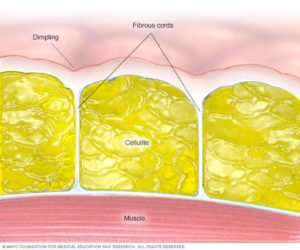Cellulite Symptoms and Causes
Cellulite Symptoms and Causes Explained
Cellulite Symptoms
Cellulite symptoms look like dimpled or bumpy skin. It’s sometimes described as having a cottage cheese or orange peel texture.
You can see mild cellulite only if you pinch your skin in an area where you have cellulite, such as your thighs.
Cellulite that is more severe makes the skin appear rumpled and bumpy with areas of peaks and valleys.
Cellulite is most common around the thighs and buttocks, but it can also be found on the breasts, lower abdomen and upper arms.
Cellulite Causes
Cellulite causes little known about. It involves fibrous connective cords that tether the skin to the underlying muscle, with the fat lying between.
As fat cells accumulate, they push up against the skin, while the long, tough cords pull down. This creates an uneven surface or dimpling.
In addition, hormonal factors play a large role in the development of cellulite, and genetics determine skin structure, skin texture and body type. Other factors, such as weight and muscle tone affect whether you have cellulite, though even very fit people can have it.
Cellulite symptoms and causes are found mostly in women.
 What is Cellulite?
What is Cellulite?
Cellulite is a very common, harmless skin condition that causes lumpy, dimpled flesh on the thighs, hips, buttocks and abdomen. The condition is most prevalent in women.
Many people try, with variable success, to improve the appearance of their skin through weight loss, exercise, massage and creams marketed as a solution to cellulite.
Medically proven treatment options are available as well, though results aren’t immediate or long lasting.
Risk factors
Cellulite symptoms are much more common in women than in men. In fact, most women develop some cellulite after puberty.
This is because women’s fat is typically distributed in the thighs, hips and buttocks — common areas for cellulite. Cellulite is also more common with aging, when the skin loses elasticity.
Weight gain can make cellulite more noticeable, but some lean people have cellulite, as well. It tends to run in families, so genetics might play the biggest role in whether you develop cellulite.
An inactive lifestyle also can increase your chances of having cellulite, as can pregnancy.
Cellulite is seen as dimpled bumpy skin with an “orange peel” appearance. Fatty tissue under connective tissue bulges into the dermis which results in the appearance of dimpled skin. This most commonly occurs in women on thighs, buttocks and upper arms.
While poor or reduced lymph circulation may be one of the causes of cellulite, genetics can also play a role.
In addition, digestive disorders, constant stress, impaired vein systems, ageing, being overweight or obese can lead to this appearance. Cellulite removal may well be on the top of the “to do” list for those who are concerned about their appearance.
Some women start to notice the signs and symptoms of cellulite from quite a young age and it is estimated that as many as 95% of all women will suffer from this condition to some extent. It is not surprising that so many will search for the best cellulite treatment available.
The female body structure is unique in that there is a septae structure under the skin which is very fibrous and mesh-like, making it prone to trap fat cells. It can take some effort and lifestyle changes to undo the damage.
How To Reduce
One way of following a natural cellulite treatment is to take up exercise like walking, swimming or yoga. Exert yourself for 20 minutes 5 times a week to return your body chemistry to a more balanced state so that cellulite is less likely to appear.
Yoga is especially helpful as it gets your leg muscles into shape while helping to smooth out spongy thighs. Yoga encourages lymph flow through fatty areas, flushing out toxins and reducing fat cells. Using a mini trampolene or rebounder can also be beneficial in the battle to help remove cellulite.
